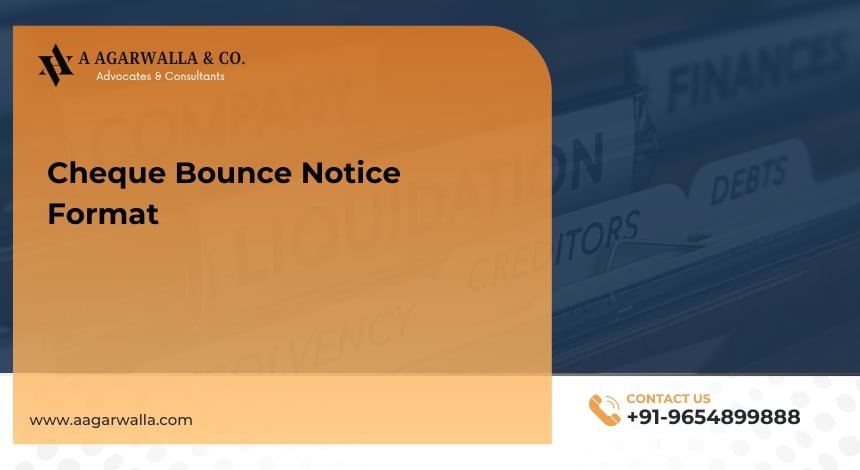Have you ever faced the issue of a cheque bounce? This common problem can arise due to insufficient funds, incorrect details or other reasons. When a cheque is dishonored, it leads to a situation known as cheque bounce, which can cause significant financial and legal stress. Sending a cheque bounce legal notice is the first step to address this issue and ensure the payee’s rights are protected. A well-drafted cheque bounce legal notice is a formal demand for the payment due and sets the reason for potential legal action if the issue remains unresolved.
A cheque bounce legal notice is served to inform the drawer of the dishonored cheque about the consequences of non-payment. The process of sending a cheque bounce notice is not only a legal formality but also a vital step to initiate the process of recovering the dues through legal channels. It is essential to understand the intricacies involved in sending such a notice and the subsequent steps that can be taken if the payment is not made. In this article, we will delve into a detailed cheque bounce notice format and discuss the procedure for sending the notice.
Legal Framework
In India, cheque bounce cases are governed by the Negotiable Instruments Act, 1881. Section 138 of this Act deals with the penalties and legal implications of a dishonored cheque. According to this section, if a cheque drawn by a person is returned by the bank unpaid, due to insufficient funds or if it exceeds the amount arranged to be paid from that account, the drawer of the cheque is deemed to have committed a criminal offence.
A cheque bounce notice must be sent within 30 days of receiving the information about the dishonor of the cheque. The notice should demand the payment of the cheque amount within 15 days from the date of receipt of the notice. If the drawer fails to make the payment within this period, the payee has the right to file a complaint under Section 138 of the Negotiable Instruments Act.
Recent amendments under section 143A of the Negotiable Instruments Act have introduced stringent measures to deal with cheque bounce cases. These include the provision for interim compensation to the complainant, which can be up to 20% of the cheque amount.
Importance of Sending a Cheque Bounce Notice
Sending a cheque bounce notice is crucial for several reasons. It serves as a formal demand for the amount due and is a mandatory step before initiating any legal proceedings under the Negotiable Instruments Act. This notice acts as a final warning to the person who issued the cheque, giving them an opportunity to settle the payment without facing legal action.
A cheque bounce legal notice informs the drawer about the dishonor of the cheque and the consequences if the payment is not made. It clearly communicates the seriousness of the situation and the potential legal trouble that could follow. By sending this notice, the payee ensures that they have complied with all legal requirements and can proceed to file a complaint if the payment is not made.
The notice typically includes the following key elements:
- Details of the bounced cheque, such as the cheque number, date and amount.
- The reason why the cheque was dishonored.
- A demand for the payment of the cheque amount.
- A timeline, usually 15 days, within which the payment should be made.
Understanding how to send a cheque bounce notice is vital. The notice should be sent via a method that provides proof of delivery, such as registered post or courier.
Key Elements of a Cheque Bounce Notice
A well-crafted cheque bounce notice format is essential for making a clear and legally sound demand for payment. Here are the key elements that should be included in a cheque bounce legal notice:
- Name and Address of the Payee: The notice should start with the name and address of the person or entity to whom the cheque was issued.
- Details of the Bounced Cheque: Include the cheque number, date, amount and the bank details where it was deposited. This helps in identifying the specific transaction in question.
- Reason for Dishonor: Clearly state why the cheque was bounced, such as insufficient funds, signature mismatch or any other reason provided by the bank.
- Demand for Payment: Explicitly demand the amount of the bounced cheque. Mention the exact amount and the urgency of the payment.
- Legal Consequences: Mention that failure to pay will result in legal action under Section 138 of the Negotiable Instruments Act.
- Timeline for Response: Specify the time frame within which the payment should be made, typically 15 days from the receipt of the notice.
Procedure for Sending a Cheque Bounce Notice
Understanding how to send a cheque bounce notice properly is essential for protecting your legal rights and ensuring the process is effective. Here’s a detailed, informative guide on the steps involved in sending a cheque bounce legal notice:
Draft the Notice
To draft a clear notice ensure it includes:
- Name and address of the payee.
- Details of the bounced cheque (number, date, amount).
- Reason for cheque dishonor.
- Demand for payment.
- Legal consequences of non-payment.
- Timeline for response (usually 15 days).
Make sure the notice is legally sound and clearly communicates the demand for payment and potential legal actions.
Review the Notice
Double-check all the details to ensure accuracy and completeness. Ensure the language is formal and polite yet firm, adhering to legal standards.
Sign the Notice
Sign the notice to validate it. Include your contact information to ensure the recipient can reach you for any clarifications.
Choose a Method of Delivery
Send the notice via registered post or courier with acknowledgment due. This method provides proof of delivery, which is crucial if the matter goes to court. Make multiple copies of the notice for your records.
Wait for a Response
Allow the stipulated time (15 days) for the drawer to respond and make the payment. If the payment is made, document the receipt of payment and consider the matter resolved. On the other hand, if the payment is not made within the stipulated time, prepare to file a complaint under Section 138 of the Negotiable Instruments Act.
Conclusion
Addressing the issue of cheque bounce effectively requires a thorough understanding of the legal processes involved. Sending a cheque bounce notice is the crucial first step in this process. The importance of a well-drafted cheque bounce legal notice cannot be overstated. It ensures that the payee’s rights are protected and that the drawer is fully aware of the consequences of non-payment. By understanding the cheque bounce notice format and the legal procedures that follow, payees can protect their financial interests and seek justice in the event of a cheque bounce.
With a deep understanding of the Negotiable Instruments Act, 1881 and extensive experience in managing such disputes, A Agarwalla & Co. ensures a seamless process from sending the legal notice to pursuing legal action if necessary. We meticulously draft legally sound and effective cheque bounce legal notices, ensuring every detail is addressed to strengthen your case.
Frequently Asked Questions
1. What is a cheque bounce notice?
A cheque bounce notice is a formal legal notice sent to the drawer of a cheque that has been dishonored by the bank. It demands payment of the cheque amount within a specified period, usually 15 days and informs the drawer of the legal consequences of non-payment.
2. What are the key elements of a cheque bounce notice?
A cheque bounce legal notice should include:
- Name and address of the payee.
- Details of the bounced cheque (number, date, amount).
- Reason for dishonor.
- Demand for payment.
- Legal consequences of non-payment.
- Timeline for response.
3. How do I send a cheque bounce notice?
To understand how to send a cheque bounce notice, follow these steps:
- Draft the notice.
- Review and sign the notice.
- Send it via registered post or courier with acknowledgment due.
- Keep copies of the notice and proof of delivery for your records.
4. What happens if the drawer does not pay within the notice period?
If the drawer does not make the payment within the notice period, you can file a complaint under Section 138 of the Negotiable Instruments Act. This may lead to legal proceedings where the drawer could face imprisonment, a fine, or both.
5. What is the time limit for sending a cheque bounce notice?
The time limit for sending a legal notice for a cheque bounce in India is 30 days from the date you receive information from the bank about the cheque’s dishonor. It is important to adhere to this timeline to ensure your right to legal recourse is preserved.


